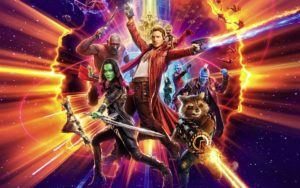
 (4 / 5)
(4 / 5)
This movie is an example of the age that we, as a movie audience and MARVEL Studios are living in right now. There is an audience that is not so stuffy that can accept weird and outlandish concepts, characters and images and a studio that has accumulated enough capital that it is willing to spend money and delivery on them.
We get our Guardians of the Galaxy back for this movie. Chris Pratt is Peter Quill/Star Lord still a handsome well meaning fool. Rocket (Bradley Cooper) that’s still so tech savvy and can piss of anyone within a few moments of being in their company. Also still an amazing C.G.I. accomplishment. Drax (Dave Bautista) who might just get the most and biggest laughs from me this time, speaking his mind, no matter how uncomfortable or offensive it might be. Gamora (Zoe Saldana) who’s more defined here, she is the level headed one and the stern fighter. Finally is Baby Groot (Vin Diesel) still growing from the last movie, a really cute design that will probably sell many, many toys.
Our opening sequence is our Guardians defending batteries from, some kind of energy eating monster. They take it down eventually, though a more coordinated team would have been able to do it better, and receive their reward from a species of gold-skinned humanoids. Though Rocket has kept a few batteries for himself, which displeases them greatly.
This comedy style can be described as wise-ass, the characters constantly poke fun of their situation and other characters in the world. It helps by not taking itself too seriously, which would be a struggle with characters and visuals this wild and ridiculous. Some of the gags go on too long, with one character not hearing or completely misinterpreting what the other said so it all has to be repeated with rising frustration. This is milking a scene however it almost plays into the comedy, it’s funny that they don’t have to be stingy with their special effects and have a scene play-out.
These movies have distinguished themselves in their lavish production value. No other movie can I think of that has brought to life such crazy concepts with such care and skill. Having bars and ships filled to the brim with all these different alien designs and meticulously designed sets that vary from pristine palaces to dingy, leaky slums.
In the last movie Peter has a cassette tape of hit songs from the eighties and before. At the end of that movie he got the next volume, so this movie once again is filled with catchy songs. They’re not all as recognisable or as catchy as the first one, but I think they fit the themes of the moment they’re played in better.
There’s a lot less going on in this movie. Less characters and less intertwining narratives, the whole thing is more focused and consistent. I criticised the first movie for wanting to reach emotional placed but never being confident enough to go there. This one has short, but sincere moments of emotion but never tries to go too deep with them and are nearly always book-ended with comedy so the whole thing is much more consistent.
In nearly every MARVEL movie Stan Lee has made a little cameo appearance. It’s been something cute for the fans to see and develop theories for. Well here, he makes a cameo again and they do something special with it. What it is I wont dare spoil, but it’s good.
This is a franchise that never excelled in it’s depth of a story, profound message or even something philosophical. No it’s strength is in it’s incompetent, but fun characters and visuals. It strikes that great genre piece that made the eighties an enjoyable decade, colour and fun.
Category Archives: Film & TV
Grantchester & the rise of the TV vicar by Gareth Williams
As Grantchester prepares to get underway with its third series on ITV, I felt it would be a good time to reflect on the recent surge in clerical figures appearing on our television screens. Whether in comedy, drama, or documentary, the rise of the TV vicar is very exciting on a personal level. But it does intrigue me that, in this supposed age of secularism in Britain, such men and women of faith are coming to the forefront of British television. They are no longer the bit part players, given only a ceremonial role in soap marriages and funeral services. Instead, TV writers, directors and producers seem to be open to the idea that these men and women of the cloth can actually lead a show. They have entrusted them as protagonists. Praise the Lord!
Any doubts that may have surfaced in the early days of this “revival” must now be put to bed. Gone are the days where the religious output of the BBC was a mere half-hour every Sunday for Songs of Praise, and the obligatory documentary to mark the Christian festivals of Christmas and Easter. Don’t get me wrong, these still exist. Most recently, Fern Britton took a trip to Jerusalem to recount the story of Jesus in Fern Britton’s Holy Land Journey. Moreover, they still have a place within the television schedules. I think the evolution of Songs of Praise to include modern and contemporary Christian music, alongside congregations belting out 19th Century hymns, reveals something of this show’s continued relevance to its watching audience. But the representation of Christians on television is now moving beyond these niche slots to feature in other, more populist, areas of the TV landscape.
Nowhere is this more evident than Sunday nights. It is perhaps apt that the traditional day of worship for Christians should also be the time when two of the biggest contemporary dramas are broadcast, both featuring clerical characters. As mentioned earlier, Grantchester begins its third series on Sunday at 9pm, having previously been broadcast on Mondays (Series 1) and Wednesdays (Series 2), again in a primetime 9pm slot. Who would have thought that a show featuring an Anglican vicar as its protagonist would regularly pull in 6 million viewers? Yes, it taps into the current popularity of murder mystery dramas. But it is not afraid to take seriously the vocation of James Norton’s character. It deals with issues of faith in a very open and unabashed way. The Revd Sidney Chambers is not perfect, and the character himself never claims to be. He wrestles with the conflict and dilemmas that emerge from his faith, sometimes overcoming them and sometimes not. Here is a man who does not think he is better than us (the traditional stereotype of TV satire) but a man who is like us. This empathetic portrayal, I believe, is one of the reasons why the TV vicar is becoming increasingly visible on our screens.
The other big Sunday night draw is the ever-popular Call the Midwife. Broadcast on Sundays since its inception, it remains the highest-rating drama on British television since the turn of the century. And at its heart is a group of Anglican nuns. Writer Heidi Thomas has created such a wonderful drama full of real human stories. Yet she does not shy away from treating the nuns’ faith with the same care and attention as the episodic story arcs of one-off characters. The sisters receive just as much dramatic attention as the nurses that work alongside them, as does the resident vicar Tom Hereward (played by Jack Ashton). There are numerous examples of these faith-filled storylines and, like in Grantchester, the conflicts and desires at the heart of these characters are explored with such depth of care and attention that one cannot fail to empathise with them. As a result, we can begin to understand and take faith more seriously. It is no longer a weird, ancient pastime but lived experience, a legitimate (and complicated) part of a person’s identity.
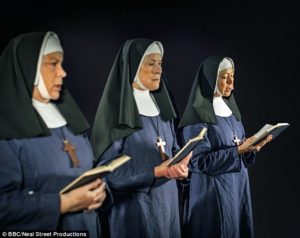
These are just two examples of the increasing presence of clerical characters on our TV screens. They are by no means alone in the growing pantheon of shows featuring a clerical protagonist. Others include: Welsh-language drama Parch (featuring a female cleric), US fantasy drama Preacher, Sky Atlantic’s The Young Pope (with Jude Law), and BBC daytime series Father Brown. But if you think this list of dramatic representations means the death of the vicar in TV comedy, think again. Recent series such as This Country (BBC3) and Hospital People (BBC1) remind us that they still have a place within the sitcom genre. They can still be figures of fun, much like anyone else. But the sitcom is no longer the only place we find them.
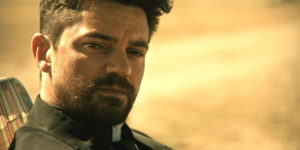
After years of unpleasant stereotyping, in which they have been satirically lambasted, played as figures of ridicule, and been a pointless but necessary figurine at weddings and funerals, it seems that the TV vicar finally has the opportunity to tell their own story. Since the arrival of Rev, the floodgates have opened to allow the small screen cleric some actual and proper screen time. This can only be a good thing, particularly in an increasingly secular culture that views faith with suspicion. So here’s to the rising prominence of Christian clerics on television. May the positive portrayals continue, and may other faith groups follow. (And I raise a glass of whisky – Sidney’s favourite tipple – rather than the stereotypical sherry as I say that.)
Review The Boss Baby by Jonathan Evans
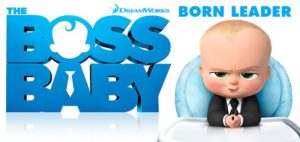
 (4 / 5)
(4 / 5)
When you are a child everything is so much more dramatic and threatening, especially when you look back on it. What was maybe a small argument escalates into an epic battle, what was most likely a chase around the garden is a fierce race. The Boss Baby understands this concept and uses to tell it’s story in the most entertaining way.
A man named Timothy (Tobey McGuire) tells a story about how when he was young (now played by Miles Christopher Bakshi) he lived with his mother (Lisa Kudrow) and father (Jimmy Kimmel). He was very imaginative and was encouraged to use his imagination to play games of adventure. All is happy, but one day a taxi pulls-up outside his house and a baby exits, wearing a suit, sunglasses and carrying a briefcase.
Alec Baldwin as the baby is so appropriately cast against type. As a serious veteran actor he’s not the first name that comes to mind when you think of sweet baby. Though this isn’t his first time in animation, he’s given his voice to Cats & Dogs, The SpongeBob SquarePants Movie, Madagascar 2 and Rise of the Guardians. He has a greatly distinctive, gravely voice that of course doesn’t work for a baby, that’s why it works, it makes the whole thing so much more absurd and funny. But also in terms of his performance he is able to be sharp and cynical, petty and bouncy. For the baby body itself, it obviously has greater maneuverability than a real baby would but stays true to the stubby proportions that real babies do.
This isn’t the first movie to have the plot of a new child coming along, the first ones that come to my mind are The Rugrats Movie and Look Who’s Talking (you could also interpret that as the plot of Toy Story, but that’s irrelevant). The point is how well it tells it’s story. This is fun, enjoyable with all it’s over-the-top acting, situations and reactions, engaging for the eyes with the energetic and colorful animation, all of it will have you smiling. The filmmakers have very effectively put themselves back in the position of a seven year old. Where they can see things and interpret them in their own logic. They also inject things for the adults but smooth it down enough so the young-lings will laugh too.
Through Tim’s imagination we are able to see many visual variations on-screen. Some are more expressionistic and stylized but they all have the vivid colors and clean lines that make it all clear and accessible for all the ages.
One thing I do question is the conflict with the baby. Sure adults will be able to tell that this is stylized fantasy, but how the young children will take it and then treat their siblings is a bit more of an iffy subject.
The animation, character designs and backgrounds are all smooth and simple. The eye’s are large and round with not much detail in terns of facial features and the animators use this to create large, clear expressions that make the characters thoughts and reactions easily understandable.
I was genuinely surprised how accessible and likable this movie was. There is a great understanding of the workings of a child but also a focused goal on telling a story with a message that playtime is probably more fun with a playmate. It will more than entertain the young children with it’s silly names, comedic timing and stimulating colors and the adults will see a well crafted story and genuine sentiment. The phrase “Fun for the whole family” gets tossed around a lot, but this one really is.
Review National Theatre Live: Twelfth Night by Danielle O’Shea
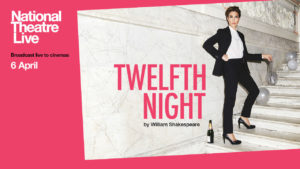
 (4 / 5)
(4 / 5)
Twelfth Night is Shakespeare’s classical comedy about love, gender and things not always being as they seem. This story became all the more poignant considering recent discussions of gender and sexuality.
In his pre-show interview, Director Simon Godwin described his interpretation as being a comedy wrought with pain and this was evident throughout. Despite the humour which trails through almost every scene, it is undeniable that each character has their own pain – whether this be due to grief or unrequited love – and Godwin made sure not to shy away from this pain but instead to embrace it. The emphasis on character was drawn even stronger by the minimalist settings which centred around a staircase that was manipulated from scene to scene from boat to church to club and so on.
https://youtu.be/O_93ev18DcY
Each member of the cast was incredible and their passion for their role was palpable however two stood out for me. Tamsin Greig as Malvolia presented a stunning portrayal of the stern turned vulnerable steward who every member of the audience empathised with whether it be from her assumed romantic triumph to downfall. In addition, Daniel Rigby forced the character of Sir Andrew Aguecheek into the spotlight with an absolutely hilarious performance that left everyone in tears.
Overall, it was a marvellous experience which was incredibly inclusive in its staging leaving little room for those unfamiliar to Shakespeare to go astray. In Godwin’s interpretation, the political and social connotations of the show were celebrated which encouraged conversation both onstage and off that had previously gone unmentioned. Altogether, it was a show that united both audience and cast in spellbinding switch-up of the classic.
National Theatre Live: Twelfth Night
Gwyn Hall, Neath
April 6th 2017
Running time: 3 hrs 10 mins
Author: William Shakespeare
Director: Simon Godwin
Design: Soutra Gilmour (Designer), James Farncombe (Lighting Designer), Shelley Maxwell (Movement Director), Michael Bruce (Music), Christopher Shutt (Sound Designer), Jeannette Nelson (Company Voice Work), Kev McCurdy (Fight Director), Alice Knight (Staff Director)
Cast: Tamara Lawrence, Daniel Ezra, Oliver Chris, Emmanuel Kojo, Brad Morrison, James Wallace, Tim Mc Mullan, Niky Wardley, Daniel Rigby, Adam Best, Doon Mackichan, Phoebe Fox, Tamsin Greig, Imogen Doel, Whitney Kehinde, Ammar Duffus, Claire Cordier, Mary Doherty, Andrew MacBean, Imogen Slaughter.
Review Ghost in the Shell by Jonathan Evans

 (3 / 5)
(3 / 5)
Mamoru Oshii’s Ghost in the Shell is one of the greatest pinnacles of intellectual science-fiction and cult fan-base. It is material that has passion from both sophisticated movie analyzers and the enthusiastic nerds that wear the t-shirts. It popularity and longevity has been more than proved so it is only natural that an English speaking studio would seek to adapt it.
The question of Ghost in the Shell has always been about the progress of technology and how that will effect humanity. What is the line or organic and the manufactured for the living?
You shouldn’t always have to compare one movie to another, you don’t need to compare 2001: A Space Odyssey to Star Wars, however you do need to compare the original Oldboy the the remake, because it has the same name and tells the same story. But how much? You also shouldn’t want the exact replica, because then it’s just a waste of time. With a remake of any sort, you need something that understands the material but tells it in it’s own unique way.
Director Rupert Sanders (who also made Snow White and the Huntsman) has a mastery of creating extremely good looking movies. He and his team have captured the world of the source material with the bright vibrant lights of all the advertisements, the dark shadows of the alleyways and the intricate as-well as organic look to the technology.
Being that it’s source material is Japanese the decision was made to incorporate a lot of Japanese aesthetics and cast members into this American adaptation. It comes off odd, I don’t know whether this actually takes place in Japan or whether or not there’s just some big cultural merging that has happened over the years.
Scarlett Johansson as the Major is different from what people are use to. She is more expressive and vulnerable, but that’s because her origin is changed (I’ll forgo that explanation). However she is still stern and commanding, can clearly combat a threat in either hand-to-hand or gunfire.
This is not a straight remake of the original, it is more like a channeling. It takes moments and set-pieces from the original and tells an altered story with it. You will recognise situations an images, but their place and context has change or altered.
The original movie was able to have loads of detail within it at times to explain certain elements of how the world works, but it also allowed other moments where it left it to interpretation original had blank spaces, this over explains.Rarely does it leave moments of ambiguity, this is more like a traditional Hollywood movie with ensuring all the questions are answered.
Is this still Ghost in the Shell? Yes, this is the world and it asks similar questions. It is not as unique or as haunting as the original but then it’s not trying to be a straight adaptation of it anyway. This is one of the best looking movies out right now and probably will be for awhile. It will also make you ask questions, not super deep questions that you can find in other Science fiction material, but their still worthwhile questions and all while being enveloped in a luscious conceived and realized world.
The Portrayal of Muslims In the Media, A Personal Response from Amina Elmi

Diversity in the media is already a huge issue that is still largely unsolved. As a Muslim, I have found that Muslims are often neglected from talks about diversity. This article aims to start a discussion on why this is and what needs to be done. Even the smallest gradual change will make a difference and will celebrate Britain as a multi-cultural nation.
In the media, we see Muslims play the role of terrorist number 3, speaking in a foreign tongue to intimidate the viewer. Many television shows and films are guilty of this. It’s tiring, stereotypical and only helps to further Islamophobia rhetoric. If that is the only version of Muslims people see, then it is no wonder that people harbour such negative views to a religion they know little about expect from what the media has shown them. Bigotry flourishes in this environment which is why change is required now more than ever.
As well as spreading prejudiced views, it is also giving the younger generation of Muslims the idea that they do not belong. With little to no representation it leaves young Muslims to perceive that the there is no play for them in the media industry. By excluding them, a whole narrative is missing, a unique perspective that won’t be shared. Yes, anyone can write a Muslim character or play one, but they will not be able to understand the unique British Muslim experience. It’s a whole generation of young people only seeing negative portrayals of themselves and accepting that’s how society sees them.
The solution? Muslims in influential roles such as directors and producers. Perhaps most crucially writers. Muslim writers have the ability to write from their own experiences that would resonate to not just Muslim viewers but to everyone. We have far more common than what divides us. If negative perceptions are tackled, then less people will be influenced by bigotry and unjustified hate. With the creation of more Muslim roles we could have more Muslim actors and actresses breaking into the industry.
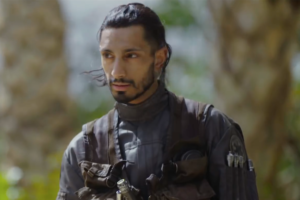
However, we have seen an emergence of Muslim characters in the past few years. Riz Ahmed, whose career has exploded in the past year has grown from strength to strength. Raised in a Muslim family, he has starred in the Star Wars and The Night Of, the latter earning him a Golden Globe nomination. He is even an advocate of more representation. I highly recommended his speech to Parliament on the lack of diversity in Britain.
http://www.nme.com/news/tv/watch-riz-ahmed-lecture-parliament-diversity-tv-2000588
Another example of positive Muslim representation, perhaps the most significant is Kamala Khan. A Marvel female Muslim superhero. It is difficult to get across how outstanding and crucial Ms Marvel (a.k.a Kamala Khan) is. She is the superhero the world needs right now.
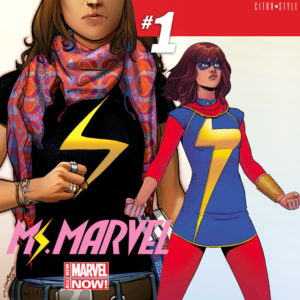
I am envious of the young girls who get to grow up with a hero that they can see themselves reflected in. Yet I am more overjoyed that she exists and is inspiring girls all over the world.
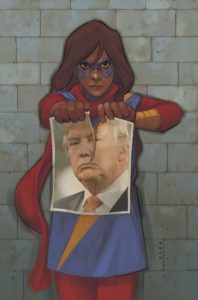
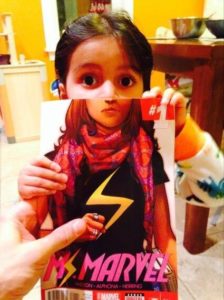
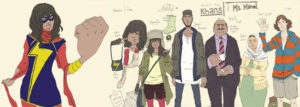
However, this is a starting point. We need more positive Muslim representation in the media to overpower the toxic portrayals that are being shown today.
https://en.wikipedia.org/wiki/Ms._Marvel_(Kamala_Khan)
http://www.vox.com/culture/2017/2/2/14457384/kamala-khan-captain-america-protest-icon
- Amina Elmi, @queenchester, Young Critic
Review Get Out by Jonathan Evans
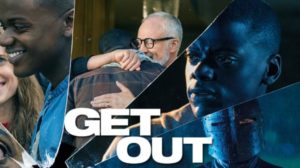
 (4 / 5)
(4 / 5)
Get Out, in it’s purest striped down form, is about being the odd one out in a crowd and environment. On the next level it is about how race relations have merely been pushed down under the surface, but to be sure, they are still the same.
Our story centers around a young man named Chris (Daniel Kaluuya), who’s a successful black and white photographer in the city and will be visiting his girlfriends Rose (Allison Williams) parents house for the weekend. He is a little nervous about meeting them though, cause he is black and she’s white. They take the drive and hit a deer on the road (never a good sign), when a police officer is taking their information he asks for Chris i.d. too, even though he wasn’t driving (equally not a good sign).
When they get to the house the parents are all too accommodating and enthusiastic. They say all the right things and act how your suppose to, but not in a genuine way. They say and act like they’ve been instructed to, smiling through toothpaste grins and offering a tour of the house simply because that’s what you do.
The performances in this movie are all sharp. Everyone is either grounded normal and convincing in that, or they are just off is a way. Like their smile is too wholesome to be genuine, or when they do it comes with a tilt of the head, making it seem wrong. It’s greatly contrasted by Chris and Rose that are people in the real world so everyone eases is strange behaviour is even more off-setting.
The creation of this movie is like a channeling of the school of Alfred Hitchcock on how to make a suspense. The camera lingers on elements and very little is said that makes the characters intentions clear. There is sharp attention to detail on the sound, most notable with the mother and how she stirs her teacup and clinks the spoon.
Adding to the Hitchcock comparisons is Michael Abels music, which is conceived in the same mindset of Bernard Herman’s score for Psycho. Completely removed from all other instruments than the strings, which make a sharp, shrieking, stabbing sensation.
One of the most surprising elements of the movie is not any of the plot twists or the imagery, but the talent behind it. Jordan Peele, the other half of the comedy duo Key & Peele, one of the most consistently hilarious sketch shows. Here he is writer director with an already deft mastery of handling a feature film. The screenplay is well-crafted, having elements that payoff later, he has bold ideas of what to do with the camera as well as able to get a wide range of performances out of his actors. If there is any complaint I can find with his execution it is that he constantly has his characters talking, instead of letting the images and what’s been said before speak for itself.
In terms of a suspense movie with shocks, it is extremely well crafted and acted. As a stylised portrayal of race relations, it’s more tricky to comment on. Recent times have shown that strong racial inequality feeling have been far from whipped out and have merely been pushed down and can come back given the chance. This movie probably serves as a reminder for that if anything else and we need to be reminded so we never fall back on our mistakes.
Review Beauty and the Beast by Sian Thomas
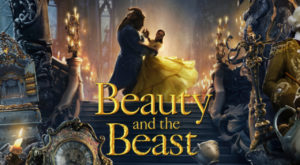
 (4 / 5)
(4 / 5)
Like everyone else, I have my favourite Disney movie and my favourite Disney princess. Beauty and the Beast has never really been one of my favourite tales. Something about the story always seemed to spook me, in a way that made me wary or apprehensive. Also, I was never as bookish as I am now, and I suppose I couldn’t relate to Belle in the way I can, now.
I want to start by saying that the film was visually stunning. It was, in all honesty, gorgeous. This includes the CGI, the minute details, the outfits. Everything. There was so much detail and so much effort put into the intricacy of the entire film that I was blown away entirely. I was in awe, so much so there were times throughout the film I felt that I’d left behind my cinema seat and been somewhere else entirely, somewhere within the story itself.
The story was the same, obviously. Though, there were newer elements added in to account for some of the plot-holes in the animated movie. I think the last time I watch Beauty and the Beast was at least three years ago. I remember that I did like it, I never completely disliked it, but I always had my disdain about the tale. This time around however, I was completely engrossed, and I liked it much more than I remembered ever feeling so before.
The songs were incredible. I don’t have much else to say about them, because in all honestly I just really and truly loved them.
I had already heard a lot about the film including a gay character. Which it did, and I was definitely glad about it. It was a lot more subtle than I had expected, though. And I had thought that the gigantic franchise that is Disney would, for sure, go a little bigger with it. I wasn’t let down, per se, I very much loved that it was included. And subtlety isn’t technically something bad, either. I had just definitely assumed that it would have been bigger. It didn’t meet my expectations, but was still great and wonderful to see on the big screen.
The movie was grand, with some parts that were truly tragic and some completely exuberant. I give it 4 stars.
Get the Chance announced as runners up in the Celebrating Diversity Award at this years Epic Awards

Get the Chance have been announced as runners up in the Celebrating Diversity Award at the 2017 Epic Awards organised by Voluntary Arts. The ceremony took place on Sunday the 19th March at the Sage Gateshead as part of BBC Radio 3’s Free Thinking Festival.
The Epic Awards were set up in 2010 by Voluntary Arts, an organisation that works across the UK and Republic of Ireland to promote participation in creative cultural activities. They celebrate the amazing contribution voluntary-led creative groups make to their communities.
https://www.voluntaryarts.org/epic-awards
The Celebrating Diversity Award is selected from across the full shortlist of 32 groups by a panel of judges representing teams in each nation. This award celebrates groups that have taken an innovative approach to highlighting the positive effects that come from living in a diverse society and is something that is central to the work that Voluntary Arts does all year round. Get the Chance were unanimously praised by the Epic Awards judges for
“The project’s unique approach to encouraging a diversity of voices”
Guy O’Donnell, Director of Get the Chance said;
“Get the Chance is honoured to be selected as runners up in the Celebrating Diversity Award. We strive to reflect the diverse nature of society in our voluntary membership. We learn from our team about barriers to sport and cultural provision and seek to work together to provide responses which are representative of all citizens in the UK.”
https://www.voluntaryarts.org/epic-awards-2017-winners
Membership of Get the Chance is free for further details please contact Guy O’Donnell, Director of Get the Chance
getthechance1@gmail.com
getthechance.wales
Review Logan by Jonathan Evans
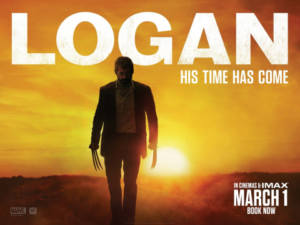
“You can run for a long time,
Run on for a long time,
Run on for a long,
Sooner or later God’ll cut you down,
Sooner or later God’ll cut down.”
-Johnny Cash, God’s Gonna Cut you Down
We are in the year, 2029, where Mutants have seemingly disappeared, or are at the edge of extinction. Wolverine’s years are beginning to show, wrinkles are more prominent, his hair is faded with a few whites as-well. Plus his healing factor is withering, he can still spit out bullets, but not at the efficient speed he once did, all the years are finally catching up to him. He’s living a life on the down-low, driving a limo, then he goes to a rusted shack where an albino named Caliban (Stephen Merchant) and a very withered Charles Xavier lives. Possibly suffering from Alzheimer’s, its unclear.
This easily has the most mature content of any of the X-Men movies. There is regular alcohol consumption, swearing (of the four letter kind) from everyone and serious, brutal action sequences. The filmmakers clearly decided that if this is their last hurrah, then they’re going out without any soft-punches.
Hugh Jackman has been playing the role of Wolverine since 2000 and has had a small role in just about ever X-Men movie. This is as much his swan song as it is for that character. He has given a lot to the role constantly having to be in-shape and energetic, which gets harder and harder to do the older you get. He is able to add, subtle tenderness as-well as gruffness to this withered character that is just plain tired and needs a rest. The whole movie is about wanting to reach a goal, or looking back and realizing you unfulfilled dreams. This is also the bleakest of nearly any Superhero movie I’ve seen. But still, there is a the noble drive to the character that wont stand to see innocents oppressed.
He is successfully keeping a low profile when a strange woman finds him, saying she needs his help, he quickly refuses but when money is offered he agrees. The jobs is the transportation of a young girl across the border.
The girl is named Laura, who has similar powers to Wolverine, for the fans of the comics they will know her as “X-23” (which she is eventually confirmed as). I wont dare spoil the details of her origin here but it is a very good inclusion of the X-Men lore. Dafne Keen plays this very complex character extremely well. She needs to have the unassuming curiosity of a child, the quiet stillness of a bad-ass as well as threatening savagery. The character is a great highlight to be written in the movie and she brilliantly brings it to life between two elderly, accomplished actors.
The action scenes in this movie work just as good on their buildup as the actual fights themselves. They are like seeing an animal being chased and then cornered until they have to attack with all fangs and claws. Wolverine is slower, both in movement and healing than he has ever been so it would be best to avoid the fights, but he is pushed so the claws must be drawn. At this point in movie history we’ve really seen it all with action movies, two people, many people, with any weapon or and setting, we’ve seen it before. Over the course of watching X-Men movies you will have seen a man with blades in his hand’s fight soldiers, and it’s variations. These scenes work because we feel them, you can see that force delivered and felt by Wolverine you hear the bones break and the cutting of the flesh. It all adds to the do-or-die nature of the whole movie.
This is the movie to end the character and the actors journey with them. Through it you will feel, you’ll find small moments to laugh at, many more to sadden and shock you. But none of the scenes go by without invoking emotion and these aren’t healed over so easily.
